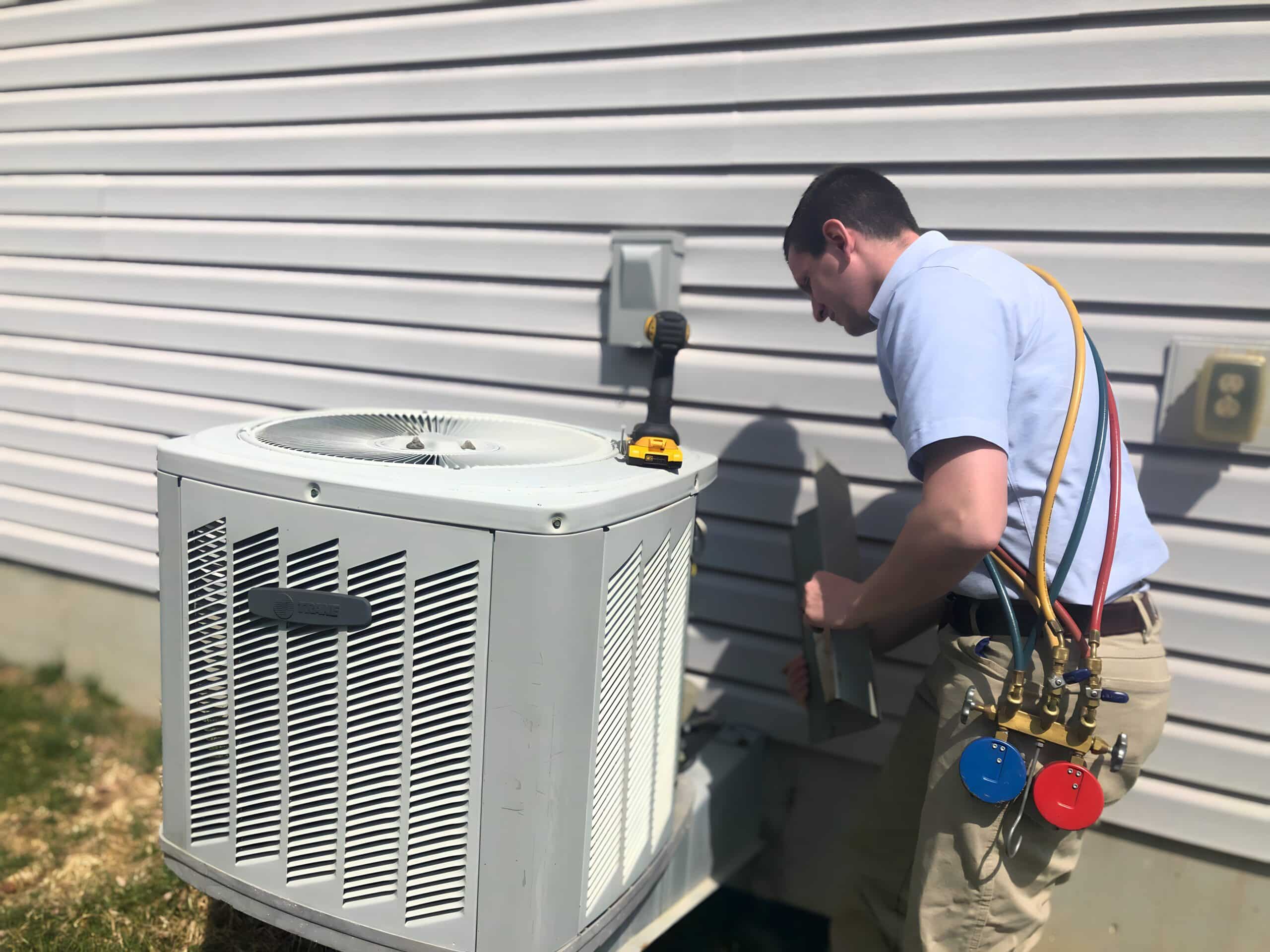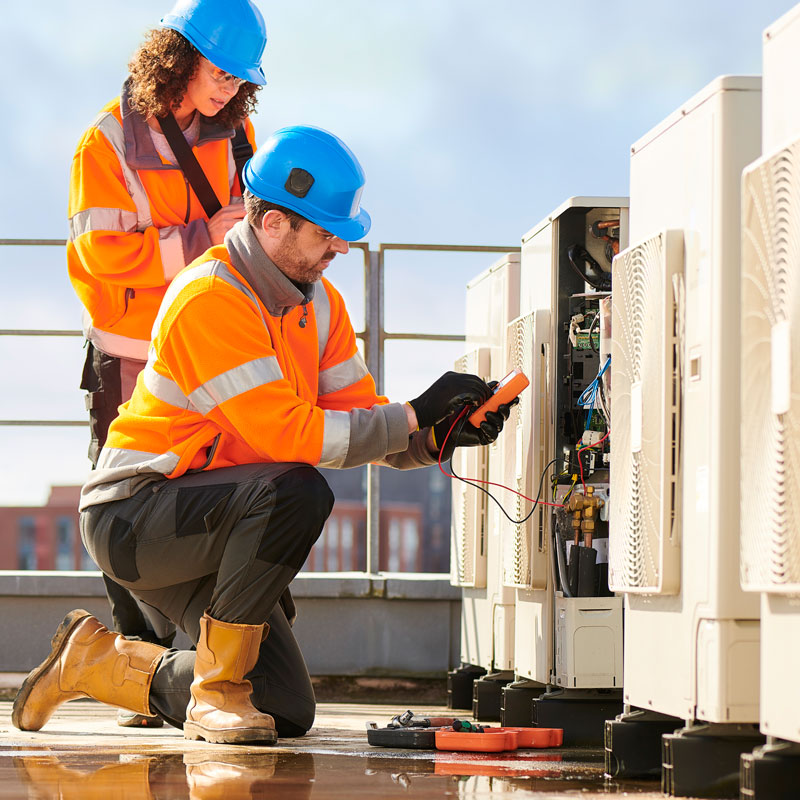Exploring the Services Provided for Mounting a Heatpump and Heater in Your Heating And Cooling Setup
When thinking about a new heating solution, home owners commonly face the decision in between heatpump and furnaces - heat pump service. Each system has unique benefits and downsides. Specialist setup plays a crucial function in ensuring optimal performance and long life of the equipment. Understanding the subtleties of the setup procedure can influence the performance of your HVAC setup. What specific solutions can improve the setup experience and guarantee performance? The solutions may shock you
Understanding Heat Pumps and Furnaces: Key Distinctions
Heatpump and heaters serve the essential feature of managing interior temperatures, yet they operate on essentially various concepts. Furnaces create heat by burning gas, such as natural gas or oil, or by making use of electrical power to warm air. This warmed air is then dispersed throughout the home via ductwork. In contrast, heatpump transfer warmth from one area to an additional, commonly extracting heat from the outside air or ground, also in cooler temperature levels. This makes them an energy-efficient option for both heating and cooling.While heaters are typically extra reliable in very chilly climates, warm pumps can give year-round temperature control, adapting to seasonal changes. The setup demands also vary, as heaters necessitate ventilation systems for exhaust gases, whereas warmth pumps call for area for outside devices. Recognizing these differences is vital for home owners evaluating their heating and cooling down options.
Benefits of Installing a Heatpump
Selecting to install a warmth pump uses a number of benefits that can enhance home comfort and power performance. Heatpump supply both home heating and cooling down remedies, making them versatile for year-round environment control. Their ability to move heat instead of produce it causes lower energy consumption, which can result in significant cost savings on utility bills.Additionally, heat pumps operate silently contrasted to standard furnace, adding to a more peaceful home environment. They also call for less upkeep, as they have fewer moving parts and do not count on burning processes.Moreover, heatpump are eco-friendly, as they make use of renewable resource sources, lowering greenhouse gas exhausts. Their setup might qualify home owners for energy efficiency discounts or tax rewards, further enhancing the economic benefits. Generally, heatpump represent a reliable, eco-conscious choice for modern-day a/c systems, ensuring comfort and sustainability.
Benefits of a High-Efficiency Heater
A high-efficiency furnace offers considerable power financial savings, which can result in minimized energy expenses for house owners. In addition, these systems contribute to a lower ecological impact by using much less gas and launching less emissions. Improved convenience degrees are likewise a vital benefit, as these heaters maintain more consistent temperatures throughout the home.
Energy Cost Savings Possible
While several homeowners look for means to reduce energy bills, purchasing a high-efficiency heater can significantly improve power financial savings. These heaters make use of innovative modern technology to transform a greater percent of fuel into usable heat, considerably improving power efficiency. With an Annual Fuel Utilization Performance (AFUE) ranking frequently going beyond 90%, high-efficiency designs can conserve home owners significant amounts on their heating costs contrasted to standard devices. In addition, they run much more quietly and call for much less regular repair work, which can even more contribute to total cost savings. In time, the preliminary financial investment in a high-efficiency heating system generally pays off via decreased energy expenses, making it an economically smart selection for those seeking to optimize their heating and cooling systems.
Environmental Effect Reduction
Buying a high-efficiency heating system not only benefits home owners economically however also considerably reduces environmental influence. These heaters operate with enhanced energy efficiency, which translates to lower greenhouse gas emissions. By consuming less energy, they lower dependence on nonrenewable fuel sources, contributing to a decrease in air pollution and helping fight environment adjustment. Furthermore, high-efficiency versions frequently use innovative innovation that lessens waste, more enhancing their environmental benefits. The shift to such systems aligns with worldwide initiatives to promote sustainability, encouraging a move towards renewable resource resources. As a result, home owners play an essential duty in cultivating a much healthier earth while taking pleasure in the advantages of reduced power expenses and improved functional performance. Such choices reflect a commitment to environmental stewardship and liable source monitoring.
Boosted Comfort Degrees
High-efficiency heaters substantially improve comfort levels in domestic spaces by keeping extra regular temperatures throughout the home. Unlike standard versions, these sophisticated systems utilize variable-speed blowers and regulating gas valves, permitting for precise temperature level changes. This technology lessens temperature changes, ensuring that each space continues to be evenly comfy. Furthermore, high-efficiency heating systems run quietly, adding to a serene indoor atmosphere. They likewise enhance interior air top quality by making use of innovative purification systems that record dirt and irritants, offering cleaner air for passengers. In addition, their energy-efficient procedure reduces utility bills, making them an affordable choice in the future. On the whole, high-efficiency heating systems not only promote a comfortable ambience yet additionally enhance the overall living experience within the home.
Expert Setup Services: What to Expect
What can house owners anticipate throughout the specialist image source installment of a heatpump and heating system? A detailed analysis of the home's home heating requirements will certainly be carried out by qualified specialists. This analysis ensures the suitable sizing of the devices, contributing to power performance and optimal performance.Once the evaluation is complete, the specialists will schedule a setup date, preparing the website for the new system. Home owners can anticipate a precise installation procedure that includes setting up the heat pump and heater, linking necessary ductwork, and assuring correct electric connections.Technicians will also examine the cooling agent degrees and evaluate the system for leakages, making sure every little thing runs flawlessly. House owners need to anticipate clear communication throughout the process, with professionals clarifying each step and dealing with any inquiries. After installation, a presentation of the brand-new system's operation will be provided, making certain property owners understand just how to use their brand-new home heating option successfully.
Routine Maintenance for Optimum Efficiency
After the professional installation of a warmth pump and furnace, regular upkeep becomes essential for making sure peak efficiency. This upkeep usually includes routine examinations and maintenance to recognize prospective issues prior to they rise. Technicians usually inspect the filters, guaranteeing they are tidy and changed as necessary, as filthy filters can use this link prevent airflow and efficiency.Additionally, examining cooling agent levels and making sure electrical connections are safe and secure is crucial for functional security and effectiveness. Regular maintenance might likewise entail cleaning up the outdoor device of the heat pump to stop particles buildup, which can influence performance.Moreover, organizing yearly tune-ups helps to prolong the life-span of the devices and preserve power efficiency. Home owners are motivated to keep records of upkeep tasks, as this paperwork can help in determining patterns and making sure timely actions. Normal maintenance not just enhances comfort however likewise optimizes power usage, bring about set you back savings over time.
Fixing Common A/c Issues
Many property owners encounter typical heating and cooling issues that can interfere with convenience and performance. One widespread concern is inadequate heating or air conditioning, commonly triggered by unclean filters, obstructed ducts, or malfunctioning thermostats. An easy check of the air filter can settle airflow issues, while obstructed vents ought to be cleared for peak performance.Another frequent issue is unusual noises, which may suggest loose components or mechanical wear. Home owners need to pay attention for squeaks or rattles and examine quickly to avoid more damage. Additionally, constant cycling can signal that the system is extra-large or that a thermostat calibration is needed.Finally, cooling agent leakages in heatpump can cause reduced effectiveness and needs to be addressed by an expert. Fixing these typical concerns can help in keeping a comfortable interior atmosphere while prolonging the life of the heating and cooling system. Seeking specialist assistance when essential warranties that these issues are settled efficiently and safely.
Expense Considerations for Heatpump and Furnace Setup

Often Asked Inquiries
The length of time Does It Require To Set Up a Heatpump or Heater?
The setup duration for a heatpump or furnace normally varies between 4 to eight hours, depending on the intricacy of the system, existing infrastructure, and the experience of the setup group associated with the process.
Exist Financing Options Available for A/c Installations?
Financing options for a/c installations differ by provider, typically consisting of flexible repayment plans, car loans, or credit report options. Home owners can discover these choices to manage costs effectively, ensuring comfort upgrades align with their budgetary constraints.
What Allows Are Needed for Heat Pump and Heater Installation?
The essential licenses for heatpump and furnace next installation commonly consist of structure, electric, and mechanical permits. Regional regulations might determine certain requirements, so speaking with the neighborhood authority guarantees compliance and promotes a smoother setup procedure.
Can I Set Up a Heatpump or Furnace Myself?
The inquiry of self-installation for a heat pump or furnace occurs regularly. Normally, it is suggested to speak with specialists to guarantee security, conformity with regulations, and optimal performance, as inappropriate setup can cause substantial problems.

What Warranties Are Generally Used on Setups?
Service warranties on installments normally vary by service provider and devices. Usually, they may consist of restricted life time guarantees on parts, one to five-year labor warranties, and particular coverage for the system's performance and performance, showing sector requirements. In contrast, warm pumps transfer warmth from one area to one more, commonly extracting heat from the outside air or ground, also in cooler temperature levels. Their ability to transfer heat instead than create it results in lower power intake, which can lead to considerable savings on utility bills.Additionally, warmth pumps run quietly contrasted to standard heating systems, contributing to a much more serene home atmosphere. What can property owners expect during the professional installment of a warm pump and heating system? Property owners can prepare for a precise setup procedure that consists of setting up the warmth pump and heater, attaching necessary ductwork, and assuring appropriate electrical connections.Technicians will certainly also inspect the refrigerant degrees and test the system for leakages, guaranteeing everything runs perfectly. When thinking about A/c upgrades, especially the setup of a warmth pump or furnace, understanding the connected costs is essential for house owners.